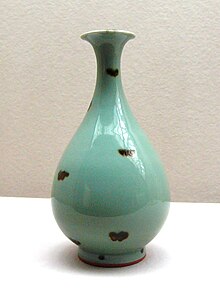Osaka Oriental Ceramic Museum
 Exterior view |
|
| Data | |
|---|---|
| place | Osaka , Japan |
| Art | |
| architect | Ryūichi Yokogawa ( 横 川 隆 一 ) |
| opening | November 7, 1982 |
| management |
Tetsurō Degawa ( 出 川 哲 郎 )
|
| Website | |
The Oriental Ceramics Museum Osaka ( Japanese 大阪 市立 東洋 陶磁 美術館 , Ōsaka-shiritsu Tōyō Tōji Bijutsukan , English The Museum of Oriental Ceramics, Osaka ) is an art museum opened in 1982 in the centrally located Nakanoshima Park in Osaka , which is one of the world's most important collections Chinese and Korean pottery houses. Among other things, two national treasures and 13 important cultural assets of Japan are exhibited .
overview
The museum was built to house and exhibit the important collection of the entrepreneur and art lover Eiichi Ataka ( 安 宅 英 一 ; 1901–1994). The collection was donated to the city of Osaka by 21 companies of the traditional Sumitomo group of companies . The collection includes around 4000 exhibits, including around 2700 Chinese, Korean and Japanese ceramics. In 1999, a side wing was opened to display more Japanese ceramics and I Byeongchang's collection of Korean ceramics ( 李秉昌 ).
Around 320 objects from the collections can be exhibited in the main building and in the side wing. There are also two special exhibitions every year. The house contains the following exhibition rooms:
- Korean ceramics ( Goryeo )
- Korean Gallery ( Joseon )
- Korean porcelain
- Collection I Byeongchang
- Japanese ceramics
- Special exhibitions
- Chinese ceramics
- Chinese ceramics ( Song Dynasty ), showcases with "natural light"
- Chinese ceramics ( Yuan - Ming Dynasty )
- Special exhibitions
China (selection)
- Celadon vase with tan points ( 飛青磁花生(龍泉窯) ) (Yuan), National Treasure
- Tenmoku tea bowl with silvery dots ( 油滴 天 目 茶碗 (建 窯) ) ( Southern Song ), national treasure
- Vase with sgraffiato decoration of peonies under green glaze ( 緑釉 黒 花 牡丹 文 瓶 (磁州窯) ) ( Northern Song ), important cultural asset
- Vessel in blue and white with fish and aquatic plants ( 青花 蓮池 魚藻 壺 (景 徳 窯) ) (Yuan), important cultural asset
- Cloisonné style vessel with birds and flowers ( 法 花 花鳥 文 壺 ) (Ming), important cultural asset
Korea (selection)
- Celadon jug (Goryeo), important cultural asset
- Celadon Vase with Peony Design (Goryeo)
- Ball-shaped bottle with bird and fish design (Joseon)
- Vessel with tiger and deer design (Joseon)
- Bottle with floral decorations (Joseon)
Japan (selection)
- Vessel, Shigaraki ( 甕 信 楽 窯 ) ( Muromachi period )
- Rectangular plate with grass and birds, Mino ( 額 皿 美濃 窯 ) ( Momoyama period )
- Plate with flowers and fruits, Arita ( 皿 花 実 文 有 田 ) ( Edo period )
- Large plate in Old Kutani style, Arita ( 大 皿 古 九 谷 様 式 有 田 ) (Edo period)
literature
- Museum leaflet, May 2004.
- Laurance P. Roberts: Japanese Museums. Simul-Press, 1987. ISBN 4-377-50737-0 .
Web links
- Official Website (Japanese)
Remarks
- ↑ The 15th head of the house, Tomoito Sumitomo ( 住友 友 純 ; 1864–1926), had donated a large library to the city of Osaka in 1904.
- ↑ Simulation with artificial lighting.
Individual evidence
- ^ Brief Outline of Our Museum ( English ) In: About Our Museum . Osaka Oriental Ceramic Museum. 2009. Retrieved June 27, 2013.
Coordinates: 34 ° 41 ′ 36.4 " N , 135 ° 30 ′ 19.7" E


